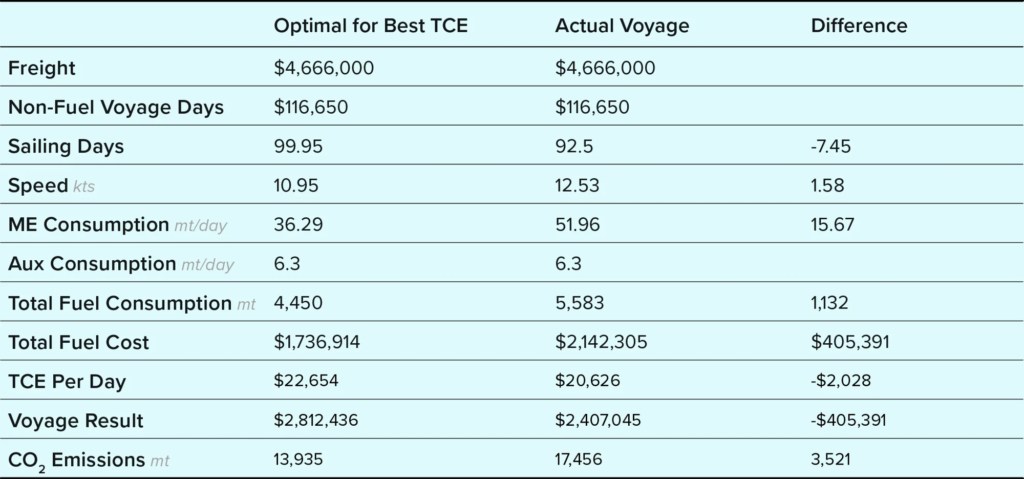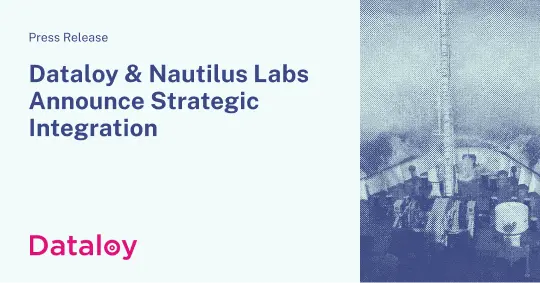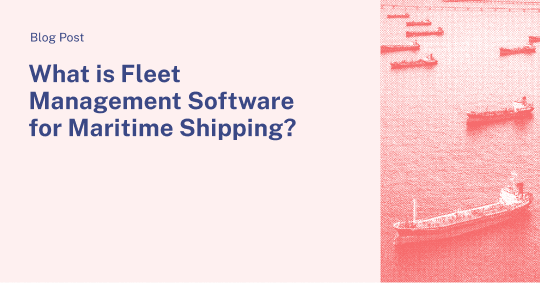A joint whitepaper between BIMCO and Nautilus Labs. Co-written by:
- Matt Heider, Chief Executive Officer, Nautilus Labs
- Grant Hunter, Director, Standards, Innovation and Research, BIMCO
- Mads Wacher Kjærgaard, Project Manager, Standards, Innovation and Research, BIMCO
- Jan Wilhelmsson, Chief Digital Officer, Nautilus Labs
Download the PDF version of the whitepaper here.
Logical actors in an illogical system.
Certain operating patterns in shipping can at times seem illogical, with vessels traveling at high speeds only to face waiting times upon arrival at port, resulting in unnecessary fuel consumption and generating additional emissions. This phenomenon, commonly known as “sail fast, then wait,” (SFTW) is influenced by a complex web of factors that drive logical actions from the perspective of the individual parties involved. Taking a step back and examining the outcome from an emissions perspective, there is no doubt the shipping industry can do better. Depending on one’s position in the value chain, the drivers behind operational decision-making can vary widely, adding further complexity to the challenge of reducing emissions in the ocean supply chain. Few will argue against the fact that the net outcome – in terms of fuel efficiency per transport work – is not as efficient as it could be. Across the industry, many studies have estimated 15-20% of emissions could theoretically be eliminated through changes in the process and speed profile alone, without a negative impact on fleet capacity. Theoretically, this could take the industry halfway toward the IMO 2030 greenhouse gas (GHG) target. With a high likelihood of even stricter requirements coming into play in the future, these types of inefficiencies will have to be tackled swiftly.
These inefficiencies are not the result of poor decision making skills or incompetence. On the contrary, with a fragmented and siloed value chain, professionals have become subject matter experts in their respective fields. As that general evolution continues, driven by competition, so does the overarching pressure to continuously improve operations. This means that teams and individuals are mainly trying to ensure their profitability in a highly commoditized industry.
The shipping industry must approach the challenges posed by new regulations and the need for improved efficiency with the understanding that individual actors have good intentions and want to do right by their stakeholders, although there may be variances in performance and execution. We must also acknowledge that the main problems are systemic – part of the industry’s legacy frameworks – and that we first need to reexamine the established processes and incentives at the root cause of these issues. What specific changes to the operating framework does the industry require to reduce GHG emissions?
Overcoming the challenges to achieve reduced emissions and compliance with the current fleet is crucial for sustainability and environmental stewardship. In this section, we will examine some of the most prevalent barriers to achieving these goals and propose alternative strategies that could be implemented to make significant progress toward a more sustainable future.
Voyage Charter Parties do not incentivize optimal arrival
The way Voyage Charter Parties are structured in both wet and dry bulk chartering have strong connections to the terms of sale of the cargo, and demurrage clauses to create checks and balances between the Owner and Charterer in regard to delays in the port operation. To provide context on voyage charters: a certain amount of lay-time is allowed on an agreed-upon voyage, and once the lay-time limit has been surpassed, demurrage is typically charged at a much higher rate than the base rate.
In reality, demurrage can be a significant revenue source for the Owner, but it also incentivizes running the vessel at high speed to arrive as early as possible – even if the berth is not available – in order to tender notice of readiness (NOR) so that the lay-time clock starts running and demurrage charges are maximized. The net outcome of this practice is a voyage with unnecessary excess fuel consumption and emissions, which ultimately produces a negative impact on the vessel’s Carbon Intensity Indicator (CII) rating.
This is a prime example of how the underlying principles in most standard Charter Party terms reward inefficiency rather than incentivize efficiency. There is a need for checks and balances to ensure the Owner does not bear the burden of risk for a long-delayed port stay that is beyond their control. In a world where the cargo often dictates the rates and margins are often small, Owners and Operators have a natural inclination to operate in a way that best benefit their businesses. New ways of working must consider commercial bottom lines, otherwise, they will not succeed. As this is not a zero-sum game – reductions in speed for a Just-in-Time Arrival would create savings, so the total pot of money becomes larger – the main challenge is about managing the distribution of that economic efficiency.
Some have attempted to remedy this problem by means of Just-in-Time Arrivals, but it has proven very difficult to implement without the support of the terminal, cargo owners, and other stakeholders involved in a port call.
While Owners are contractually allowed to maximize demurrage by arriving at the port at the earliest possible date, there are ethical concerns about the environmental implications of such a practice. As public opinion increasingly raises scrutiny, this specific wasteful SFTW practice will likely soon become something of the past.
The Rt. Hon. Dame Elizabeth Gloster DBE, Chair of Legal UK, recently referred to the practice of demurrage as “a practice that has evolved over 150 years, and originates from when vessels transitioned from sail to steam and is now a dinosaur that refuses to lay down and go extinct.”
The recent advancements in technology have opened up new possibilities for collaboration between Charterers and Owners, leading to win-win outcomes for both parties. With the help of sensors and machine learning, outcomes can now be adequately predicted. This presents an opportunity to use these technologies to more efficiently comply with new GHG regulations and drive commercial success. However, this also requires a re-examination of the Charter Party framework in light of current market conditions to incentivize optimal voyage results that not only maximize revenue but also minimize emissions.
“First-come, first-served” port operations
Despite the industry’s decarbonization goals, globally, many major public terminals and ports continue to operate on a first-come, first-served basis, leading to a race to queue, fuel wastage, and unnecessary emissions. While some ports may believe that this is what vessel operators prefer, there is an urgent need for ports to explore alternative approaches to working, leveraging new technologies and untapped potential to address these challenges and meet decarbonization targets.
SFTW behavior runs contrary to the objectives of emissions reduction and fuel efficiency. Nevertheless, it is important to recognize that port operations can be unpredictable, with planning horizons often ranging between 24 to 48 hours at best. The industry needs to make a concerted effort at developing a more structured inbound planning process. One possible approach is to target the best possible berth availability, thereby reducing the unnecessary waiting time down to actual operational delays. Many organizations in the private and public sectors have been working toward this goal for some time, and a viable solution may soon emerge. However, these solutions will likely be fragmented and small in scope without broader standards in place.
Time Charter Parties are set up to create checks and balances between the Charterer and Owner in a way that does not drive optimal efficiency
Time Charter Parties (TCPs) do not inherently drive increased emissions. Charterers pay for fuel and control the speed within a reasonable range. In principle, it would be in their best interests to operate as efficiently as possible.
In reality, there are a number of ways that Time Charter contracts often result in sub-optimal speed, primarily caused by split incentives.
While not directly related to speed, split incentives on fuel efficiency are a very real problem. Owners have little incentive to spend time and money on making a vessel more fuel-efficient when they neither pay for fuel nor reap direct benefits from increased efficiency. Instead, the risk of claims resulting from breach of speed and consumption warranty clauses poses a greater threat to Owners. However, with the introduction of CII regulations, the motivations for Owners and Charterers are shifting, with a new impetus for a more collaborative relationship between the two. Operational silos, in combination with split value chains, also often prevent optimal operations in strange ways.
Consider this example where a Charterer operating on a time charter in a soft market requested a lower speed for the vessel that was still within a reasonable range. Initially, the Owner refused the Charterer’s request, citing additional maintenance costs, and put a floor at 2 knots above the requested speed. The Charterer then consulted with the third-party technical manager who provided information on the additional cost of clearing out exhaust residue buildup at USD 15 per hour for an average of 4 man-hours of overtime per day. The Charterer realized that for an offset cost of USD 60 per day in overtime, they were burning USD 5,000 worth of excess fuel. The matter was quickly resolved with additional invoicing. This example highlights the silos that exist within the industry, where stakeholders may be focused solely on their own responsibilities without considering reopening negotiations. As technology improves, there is an opportunity to break down these silos and drive collaborative solutions for more optimal and efficient voyages.
So why would the industry want to move away from a methodology of claims that has been working for a long time? Could we not simply collaborate a bit more actively and achieve incrementally better results, like in the example above?
During a conversation with a major tanker Charterer, they revealed that they often have ships that cannot be operated at their preferred speed due to having only one warranted speed for ballast and laden conditions. Despite knowing that these ships are underperforming, the Charterer was forced to operate them at full sea speed in order to make a claim. This creates a dilemma in a soft market where the Charterer would prefer to operate at a slower speed, but doing so would void their claim case.
Case Study Example
This is a typical speed inefficiency that often results from contractual restrictions. Depending on the specific segment, the underlying reasons may vary. It could be due to the desire to maximize demurrage, the need to maintain a single warranted TC speed for claims purposes, or the result of sales terms of the transported goods. The outcome is a voyage with a less profitable and more emissions-intensive speed. In this scenario, a VLCC was compelled to maintain its warranted TC speed rather than adopting the most optimal speed.

Among Owners and Charterers, companies have different strategies and corporate cultures. With some variation between segments, some Charterers will choose to take a very hard stance on every aspect in the TCP, and systematically raise performance claims against even minor deviations, or off-hire the vessel for even the smallest repair without impact on the voyage. This practice makes collaboration difficult. Other Charterers will look at the bigger picture and value longer-term cooperation with the Owner. Similarly, there are Owners that are very proactive on efficiency, actively seeking to offer up the best-performing vessel possible and taking pride in meeting warranted speeds and consumptions. Others may choose to play the game and see what will pass. Overstating the performance of the ship in the TCP and hiding behind low weather and sea-state limits as an excuse, while citing low consumption and high speeds during good weather. The methodology of shifting the reported consumption between days to prove better TCP compliance is common.
In terms of emissions reporting, it may be argued that there is likely no breach of the law since the total consumption for the voyage remains the same. However, this practice can result in distorted reporting data, making it difficult for operators who are actively monitoring hull and propeller fouling for efficiency purposes to have clear visibility. Such distorted data can undermine the efforts to optimize vessel performance and lead to missed opportunities for improved environmental performance.
The current binary approach where one is either compliant or not, with only the claims methodology in place to create checks and balances, may not suffice in a more complex operational environment, especially with the introduction of regulations like CII and the European Union Emissions Trading System (EU ETS). As a result, there is a growing need to evolve the current speed and consumption warranties to something more dynamic that better aligns incentives for making the vessel more efficient, making TCPs more collaborative. This should involve creating financial benefits for Owners when vessels perform more efficiently, rather than simply relying on the threat of a claim for non-compliance. To achieve this, we need to shift away from the claims-based approach and leverage connectivity and third-party modeling to drive improvements collaboratively while still retaining balanced guarantees that vessels will perform at a certain level.
In considering the implementation of more dynamic TCP warranty clauses, it is important to acknowledge the potential shift in the distribution of financial risk. The traditional model of TCPs provides predictable income for a fixed daily rate over a long period, which may be disrupted by the introduction of dynamic bonus/deduction clauses. On the other hand, if the vessel really is underperforming, a performance claim at the end of the period may very well prove to be a much worse cash surprise than a continuously well-monitored and adjusted performance. The possibility of an Owner’s financial upside should not be a major issue.
Conclusion
Many of the systemic inefficiencies discussed in this paper have the potential to be resolved by rewriting key Charter Party clauses, thereby laying the foundation to redefine the rules of engagement between Owners and Charterers. The incentives of Owners and Charterers now have more overlaps, creating a relationship where collaboration and trust is a prerequisite for mutually beneficial outcomes. This is not a zero-sum game: emissions reduction and financial savings come hand-in-hand. We simply need to implement ways of working together that financially benefit both parties, as well as the environment.
These are some key changes that will be required to reduce emissions:
- More aligned incentives between Owners and Time Charterers: this will remove the focus on claims, and encourage collaboration to improve vessel efficiency
- Time Charter Party terms that financially reward Owners for making improvements to the vessel
- Time Charter Party terms that incentivize maintaining a specified CII grade, with joint accountability between Owners and Charterers
- A move away from single warranted speeds that drive sub-optimal performance for claims purposes
- New and improved Voyage Charter Party terms to make Virtual Arrivals, Just-in-Time Arrivals, and similar schemes viable and broadly adopted modus operandi, eliminating SFTW behavior


